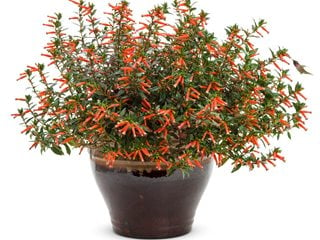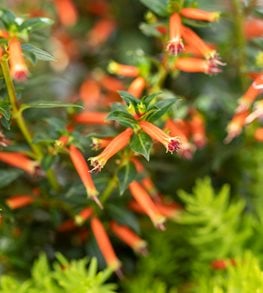How to Grow & Care for Cuphea
More gardeners are going crazy for Cuphea, a heat- and drought-tolerant summer annual that produces spectacular blooms all season long.
Vermillionaire® large firecracker plant (Cuphea hybrid). Photo by Proven Winners.
Are you tired of planting the same humdrum mix of annuals in your garden beds and containers year after year? If so, Cuphea is just what you need to break out of your rut and rev up your summer color palette.
Cuphea is gaining widespread appeal because of its outrageous array of flower colors and profiles. Although the flowers are small, they are abundant, and their vivid colors and sweet nectar make them absolutely irresistible to hummingbirds, butterflies, and other pollinators.
Cuphea loves summer sun and heat, and when grown as an annual, it will bloom nonstop until the first frost. If you live in a frost-free climate, you can also grow it as an evergreen perennial. In recent years, breeders have introduced new cuphea hybrids with showier flowers on more compact plants, giving you even more options and color combinations to choose from.
On this page: Basics | Types | Planting | Care | Cuphea Pictures | Landscaping Ideas
BASICS
Botanical name:
Cuphea (KOO-fee-ah)
Common names:
Firecracker plant, cigar flower, Mexican cigar plant, bat flower, bunny ears, false heather
Plant type:
Tender perennial, grown as an annual in most climates.
Zone:
8-11
Height/spread:
1 to 3 feet
Bloom time:
Late spring until frost
Light preference:
Full sun
Flower colors and characteristics:
Both sides of the color wheel are represented, from warm and spicy reds and oranges to cool pink, lavender, and purple tones. Cultivars with pure white blooms are also available. The blooms are typically tubular in shape, but some sport ear-shaped petals that give them the whimsical appearance of tiny mice, bats, or bunnies.
Foliage:
Bright green to blue-green, typically glossy and oblong
Special features:
- Attracts hummingbirds and butterflies
- Heat and drought tolerant
- Needs no deadheading
- Pest and disease resistant
TYPES OF CUPHEA
There are more than 250 species of Cuphea, most of them native to Mexico and Central and South America. However, only a handful are cultivated for ornamental use. The following types are among the most popular and are usually available at local nurseries or by mail-order, either as seeds or potted plants.
- Firecracker plant (Cuphea ignea)
- Bat-faced cuphea (Cuphea llavea)
- Mexican or false heather (Cuphea hyssopifolia)
- Candy corn plant (Cuphea micropetala)
- Cuphea hybrids
PLANTING
Where to plant:
In full sun or part shade in compost-rich, well-drained soil. Where summers are hot and dry, cupheas benefit from a bit of shade.
When to plant:
In late spring, after all danger of frost has passed.
Growing from seed:
You can sow seeds directly in the garden after the soil has warmed in the spring or start seeds indoors 10 to 12 weeks before the last frost. Seeds need light for germination, so don’t cover them up with soil; just press them lightly into the surface. Keep the soil moist until germination occurs, usually within 8 to 10 days.
Although cupheas are easy to start from seed, the seeds won’t germinate outdoors in temperatures below 70° F. Unless you live in a temperate climate, you’ll have better results purchasing container-grown plants or starting seeds indoors.
CARE
Watering:
Water regularly until plants become well established, keeping the soil evenly moist but not soggy. Once they take root, plants can tolerate drier growing conditions.
Fertilizing:
To keep your cuphea plants flowering vigorously all season, fertilize them regularly with a water-soluble fertilizer, or once in the spring with a slow-release granular fertilizer. Potted plants may need more frequent applications.
Pruning and deadheading:
Cupheas are self-cleaning, so no deadheading is needed to ensure continuous flower production. If you want to make your plants bushier and more compact, you can prune or pinch them back in late spring to encourage more branching and, in turn, more flowers.
Common pests and problems:
Although cupheas are generally pest resistant, they may occasionally be bothered by Japanese beetles, whiteflies, and aphids.
CUPHEA PICTURES
LANDSCAPING IDEAS

If you love warm, citrusy colors, try Vermillionaire® in this container recipe from Proven Winners, along with Superbells® Dreamsicle® and Superbells® Double Amber calibrachoas.
There are many ways to include cuphea in your garden, here are a few suggestions:
- As an annual in garden beds and borders.
- In mixed containers with other sun-loving annuals or perennials.
- As an evergreen shrub (in warmer climates).
- A good addition to a pollinator garden or hummingbird haven. (See more plants that attract hummingbirds.)
- In colder climates, potted cuphea can be moved indoors in the fall and grown in a warm, sunny location as a houseplant.
RELATED:
Annual Flowers
How to Grow Calibrachoa










